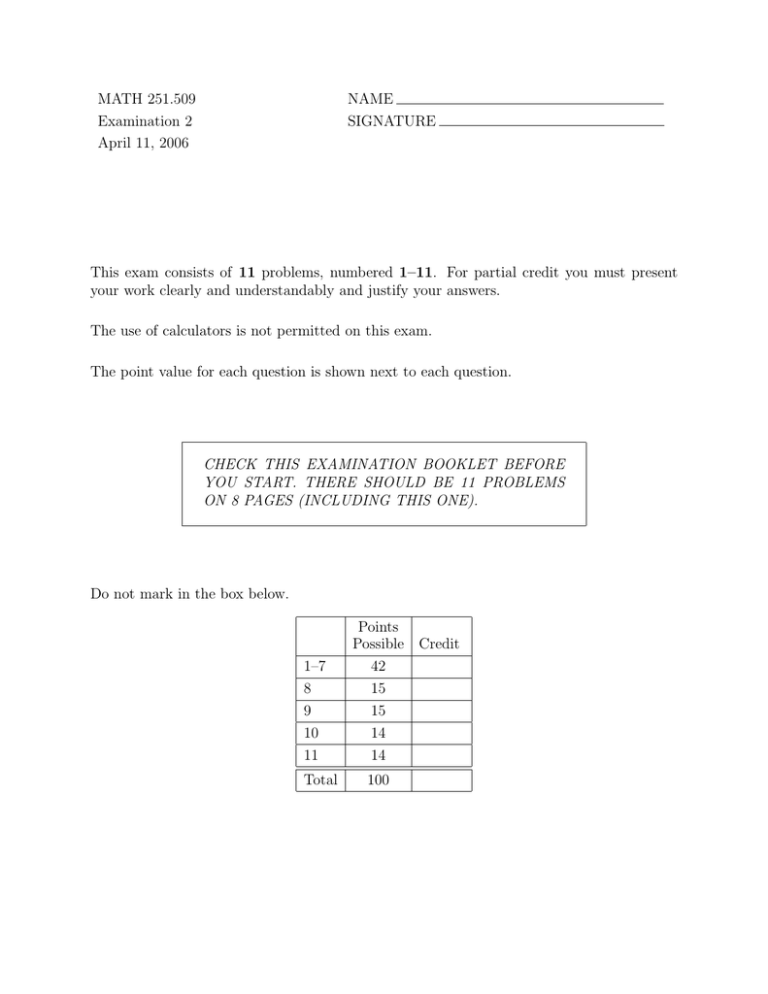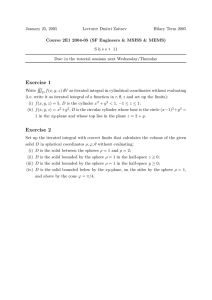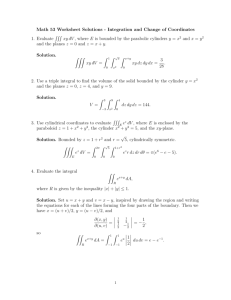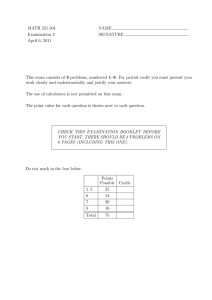MATH 251.509 NAME Examination 2 SIGNATURE
advertisement

MATH 251.509 Examination 2 April 11, 2006 NAME SIGNATURE This exam consists of 11 problems, numbered 1–11. For partial credit you must present your work clearly and understandably and justify your answers. The use of calculators is not permitted on this exam. The point value for each question is shown next to each question. CHECK THIS EXAMINATION BOOKLET BEFORE YOU START. THERE SHOULD BE 11 PROBLEMS ON 8 PAGES (INCLUDING THIS ONE). Do not mark in the box below. 1–7 8 9 10 11 Total Points Possible 42 15 15 14 14 100 Credit NAME MATH 251 Examination 2 Page 2 Multiple Choice: [6 points each] In each of Problems 1–7, circle the best answer. 1. Let f (x, y) be a differentiable function on the closed disk D of radius 4 centered at (0, 0) in the xy-plane. Suppose we know the following information: • f (x, y) has critical points at (x, y) = (1, 1), (x, y) = (2, 3), and (x, y) = (−1, 2); • f (1, 1) = 3, f (2, 3) = −5, and f (−1, 2) = 1; • f (x, y) = 0 for all (x, y) on the boundary of D. Consider the statements: I. The absolute maximum value of f (x, y) on D is 3. II. f (x, y) has a saddle point at (x, y) = (−1, 2). III. f (x, y) has a local minimum at (x, y) = (2, 3). Which of these statements must be true? (A) I only (B) II only (C) I and II only (D) I and III only (E) I, II, and III 2. What is the equation of the tangent plane to the graph of e2x cos(yz) + 2x2 − z 3 = 0 at the point (0, 0, 1)? (A) x + y + z + 3 = 0 (B) 2x − 3z + 3 = 0 (C) x − 3y + 1 = 0 (D) 2x − y + z + 1 = 0 (E) 2x − y − 3z + 3 = 0 April 11, 2006 NAME 3. MATH 251 Examination 2 Page 3 Let R be the region in the xy-plane bounded by y = x2 − 1 and y = x + 5, and let m be its mass. If R has a mass density per unit area given by the function ρ(x, y) = exy , which iterated integral below gives the x-coordinate of the center of mass of R? Z Z 1 3 x+5 xy (A) xe dy dx m −2 x2 −1 3 1 (B) m Z 1 (C) m Z 1 (D) m Z 1 (E) m Z −2 2 2 x2 −1 Z xexy dy dx 0 Z x+5 exy dy dx x2 −1 −3 3 yxxy dy dx x+5 −3 2 x2 −1 Z Z x+5 xexy dy dx x2 −1 √ 4. What are the points in polar coordinates (r, θ) where the two circles r = r = 2 cos θ intersect? √ √ (A) ( 3, π2 ) and (− 3, 3π ) 2 √ √ ) (B) ( 3, π3 ) and (− 3, 2π 3 √ √ (C) ( 3, π4 ) and (− 3, 3π ) 4 √ √ (D) ( 3, π6 ) and (− 3, 5π ) 6 √ √ (E) ( 3, 0) and (− 3, π) 5. The point P has spherical coordinates (ρ, θ, φ) = (2, π4 , π6 ). What are its cylindrical coordinates (r, θ, z)? 3 and (A) (1, π4 , 2) √ (B) (2, 2, − π6 ) √ (C) (4, π4 , 3) √ √ (D) ( 2, π4 , 3) √ (E) (1, π4 , 3) April 11, 2006 NAME MATH 251 Examination 2 Z 6. Z If we change the order of integration on the integral √ Z √ 3 Z y2 f (x, y) dx dy we obtain 0 which integral below? 0 x (A) f (x, y) dy dx 0 0 9 Z √ Z x f (x, y) dy dx (B) 0 0 9 Z 3 Z (C) √ 0 √ Z 3 3 √ 0 3 Z f (x, y) dy dx x Z (D) √ Z (E) f (x, y) dy dx x x f (x, y) dy dx 0 7. 3 Page 4 0 Let T be the tetrahedron in the first octant whose vertices are the four points (0, 0, 0), (2, 0, 0), (0, 3, 0), and (0, 0, 6). Which integral below expresses the volume of V ? Z 3Z 2Z 6 (A) dz dx dy 0 0 3 Z 0 2 y+2 3 Z 6−3x−2y Z dz dx dy (B) 0 0 2 Z 0 − 32 x+3 Z Z 6−3x−2y (C) dz dy dx 0 Z 0 6 Z 0 − 12 z+2 Z 6−3x−z (D) dy dx dz 0 0 0 (E) None of the above. April 11, 2006 NAME 8. MATH 251 Examination 2 Page 5 [15 points] Let 1 f (x, y) = xy − x3 − y 2 . 3 Find all of the critical points of f (x, y) and classify each of them as either a local maximum, local minimum, or saddle point. Justify your answers. April 11, 2006 NAME 9. MATH 251 Examination 2 Page 6 [15 points] Let T be the solid in 3-space bounded above by the paraboloid z = 12 − 2x2 − 2y 2 and below by the plane z = 4. (a) Express the volume of T as an iterated double integral in rectangular coordinates. (b) Express the volume of T as an iterated double integral in polar coordinates. (c) Find V . April 11, 2006 NAME MATH 251 Z 10. 2 Z 4 [14 points] Consider 0 2x 1 p 1 + y2 Examination 2 Page 7 dy dx. (a) Sketch the region of integration in the xy-plane for the integral above. Be sure to label the parts of your sketch. (b) Evaluate the integral. April 11, 2006 NAME 11. MATH 251 Examination 2 Page 8 p [14 points] Let E be the solid in 3-space bounded above by the cone z = x2 + y 2 and below by the paraboloid z = x2 + y 2 . Suppose that E has a mass density of δ(x, y, z) = 3xyz. (a) Express the volume of E as a triple integral in rectangular coordinates. (You need not evaluate the integral.) (b) Express the mass of E as a triple integral in cylindrical coordinates. (You need not evaluate the integral.) April 11, 2006





